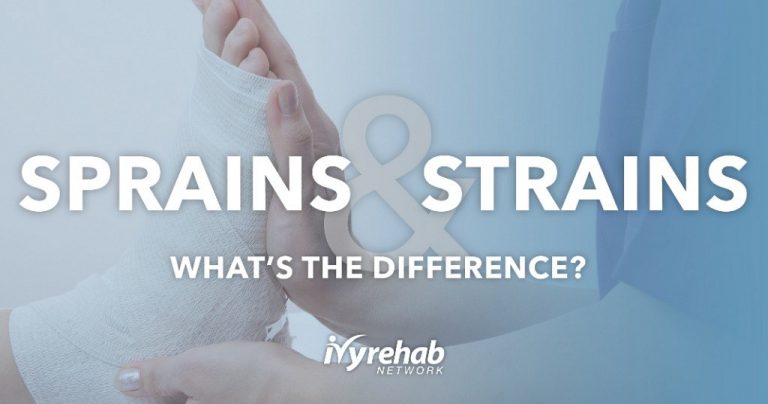
Sprains and Strains – What’s the Difference?
Have you ever wondered what the difference is between a sprain and a strain, especially when you have an injury? A sprain is an injury of a ligament. Ligaments connect one bone to another, creating joints. A strain is an injury involving muscle or tendon. A tendon is a fibrous structure that connects muscle to bone. Either of these injuries can occur from abnormal use or overloading the muscle or ligamentous structures that maintain joint stability.
Sprains and Strains Examples
Here are two examples of such Spraininjuries: an ankle (joint) sprain and a biceps (muscle) strain. Sprains and strains are separated in severity by a grading method; the more damage to the muscle or ligament that occurred, the higher the number given to identify the injury. Grades I and II involve stretching and/or partial tearing of the aforementioned structures. A grade III sprain or strain would signify a severe or complete tear of the tissue. You may even hear a pop or feel something tear. Common causes of sprains and strains include falling on your arm or rolling your ankle, lifting an object (heavy or light) improperly, overusing a muscle, or twisting.
Signs and Symptoms
Symptoms of sprains and strains can vary in their presentation. Both sprains and strains can be accompanied by pain occurring with or without movement. When identifying a sprain, however, it is important to look for any localized swelling and bruising. It is important to remember that a sprain involves compromise to the ligaments of a joint, which hold the bones together. If these are injured, it may even be difficult to use or move the joint in question. A strain, on the other hand, may produce weakness and pain accompanied by muscle spasms and cramping. Each of these injuries may also result in decreased joint range of motion and muscle flexibility.
Your physician and/or physical therapist should complete a thorough evaluation and examination to determine the degree of injury that has occurred. Your doctor will perform, if necessary, diagnostics tests such as x-rays, CT scans and MRI for your injury or recommend you to see a physical therapist.
At Ivy Rehab, our physical therapists can evaluate and treat with or without a prescription and perform special manual tests on the limb in question to provide stress to the muscles, ligaments and surrounding tissues to narrow down which injury has occurred. They will assess your ability to perform active movements and functional tasks such as walking and climbing stairs or reaching for and lifting an object.
Plan of Care
Acute injuries (less than 72 hours since the onset of injury) should be treated using the principles of RICE: rest, ice, compression and elevation. Ice is typically applied if the injury is hot, swollen, bruised and/or painful. If the injury is chronic, however, heat can also be used. It is important to decrease the stress on the injury to facilitate recovery but immobility for long periods can also be detrimental, resulting in joint stiffness and muscle tightness.
A physical therapist can perform, and instruct you in:
- Gentle range of motion to facilitate the mobility of both muscles and joint structures
- Stretching and gradual resistive exercises may be introduced to facilitate flexibility and strength of the muscles and structures of the joint.
- Activities should be modified and performed as tolerated, then gradually progressed toward full activity to lessen the risk of irritating damaged tissues
- Maintaining your physical well-being through a home exercise program may reduce the risk of such injuries occurring again
Physical Therapy is an excellent means of establishing a healthy and safe program of exercise to meet your goals as well as treat sprains and strains. Get in touch with your local Ivy Rehab clinic location to set up an appointment for an evaluation.
Article Reviewed by Holly Lookabaugh-Deur, PT, DSc, GCS, CEEAA
Holly Lookabaugh-Deur, PT, DSc, GCS, CEEAA is a practicing physical therapist and a partner and Director of Clinical Services at Ivy Rehab Network. Deur is board certified as a geriatric clinical specialist and certified exercise expert for aging adults with more than 35 years of clinical experience. She is certified as an aquatic and oncology rehabilitation specialist and serves as adjunct faculty at Central Michigan University and Grand Valley State University.
The medical information contained herein is provided as an information resource only, and does not substitute professional medical advice or consultation with healthcare professionals. This information is not intended to be patient education, does not create any patient-provider relationship, and should not be used as a substitute for professional diagnosis, treatment or medical advice. Please consult with your healthcare provider before making any healthcare decisions or for guidance about a specific medical condition. If you think you have a medical emergency, call your doctor or 911 immediately. IvyRehab Network, Inc. disclaims any and all responsibility, and shall have no liability, for any damages, loss, injury or liability whatsoever suffered as a result of your reliance on the information contained herein.